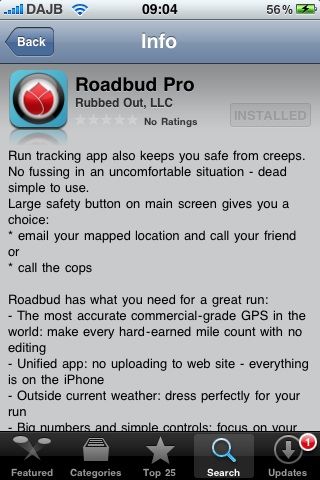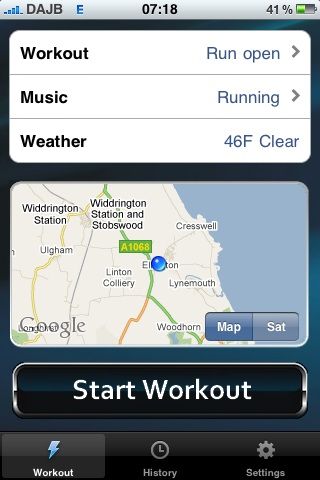Roadbud: a new iPhone app for runners [Review]
Background
 I’ve explained many times on this blog about how great running is for your whole system of productivity. The trouble with running, though, is that it used to difficult to set yourself goals and targets. With the advent of Nike+ and GPS-enabled devices, however, all that has changed.
I’ve explained many times on this blog about how great running is for your whole system of productivity. The trouble with running, though, is that it used to difficult to set yourself goals and targets. With the advent of Nike+ and GPS-enabled devices, however, all that has changed.
I first started GPS-tracking my running with my Nokia N95 a few years ago. I still haven’t found anything better than the Nokia Sports Tracker for ease-of-use and useful feedback, if I’m honest.
Since switching to an iPhone, I’ve tried a number of applications that can GPS-track my runs. Most recently I’ve been using SportyPal which I found pretty good and at a nice price (free!)
A few months ago, Mike Schoeffler, the developer of a new iPhone running app called Roadbud started following me on Twitter and reading this blog. I ended up joining the mailing list for updates and a free copy of the app upon release. After some delays, it was available in the App Store earlier this week.
For reasons only known to Apple, the free codes Mike generated are only available in the US (see the end of this post to win one for yourself!) Mike very kindly reduced the price of the UK version from £5.99 to £0.59 so that he kept his promise. Very noble and much appreciated (but this review remains impartial!) 😀
Review
 Given that SportyPal, my previous iPhone running app of choice, is free and Roadbud Pro is £5.99 it had better do something special. Fortunately, it has go some unique features. Not least:
Given that SportyPal, my previous iPhone running app of choice, is free and Roadbud Pro is £5.99 it had better do something special. Fortunately, it has go some unique features. Not least:
- Integration with iTunes music library
- StrongSong (Nike+ style motivational track you can nominate for one-button access)
- Audio feedback on distance covered, time and pace
- Google Maps integration as you run
- Weather information
- One-button access to phoning a friend or emergency services (if concerned about safety)
- Twitter integration (option to tweet your run straight after workout)
- Auto screen-lock
There is a free version (Roadbud Rookie), to be fair, but to my mind that version doesn’t offer anything over-and-above SportyPal. It’s six and two threes…
Whilst I can only give my opinion about Roadbud and my particular running regime, there’s some things I really liked and some things that I thought could probably do with some improvement.
The good:

- Integration with iTunes music library is a real bonus.
- I love the one-button access to my ‘StrongSong’ for when I need that extra boost.
- The Google Maps implementation is seamless and shows at-a-glance whether your iPhone is locked-on to the GPS signal.
- The audio feedback is useful for focusing on running instead of having to keep looking at the screen.
- You can choose a workout length (time or distance) with your progress then being shown as a bar underneath time elapsed. Nice!
Room for improvement:
- Track information of the song currently playing.
- Feedback when you’ve lost GPS signal.
- Lower power consumption (25 min run took 40% of my battery life on iPhone 3G)
- A website, like SportyPal to develop more of a community.
- The ability to export data to Google Earth.
From my contact with the Mike, the first three of the above are already in development for the next version of Roadbud. 🙂
Of course, people have different concerns and needs than me. For example, when my wife gets my iPhone in a couple of months, she’ll no doubt want to use it for running. I’ll then be really glad of Roadbud’s one-touch emergency call facility.
Conclusion + free codes
Would I recommend Roadbud? Yes.
Do I think it’s worth £5.99? At present, probably not.
I’d expect it to be more of a £2.99 app. I certainly think it’s got potential to be worth the higher price, though! I’m looking forward to seeing how it improves given that the developers keen to make it the best it can be. 😀
Want a free version of Roadbud Pro? I’ve got 3 free copies* for those who reweet this post (using the button below) before midday on Sunday 2nd May 2010!
*US residents only, I’m afraid, for reasons given above…






